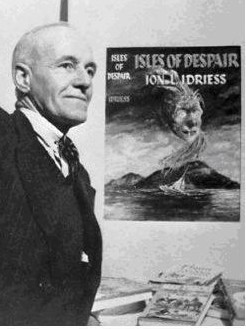
Born on 20 September 1889 at Waverley, Sydney, son of Walter Owen Idriess, sheriff's officer from Wales, and his native-born wife Juliette Windeyer, née Edmunds. Registered as Ion Windeyer at birth, he liked to be known as 'Jack'. Fittingly for a great traveller, his earliest memories were of travelling with his family: Tenterfield, Lismore, Tamworth, then Broken Hill where he completed his education at the superior public school and the School of Mines and where he gained a job in the assay office of the Broken Hill Proprietary mine. Idriess claimed that when 15 he almost died in the typhoid epidemic which killed his mother. He was sent to his grandmother in Sydney and found work on a paddle-steamer on the run to Newcastle. After a typhoid fever relapse he went ashore and worked in the western districts of New South Wales as a rabbit poisoner, boundary rider and drover. Lightning Ridge drew the young man; but the several hundred pounds' worth of opal he found he 'blued' in three months before heading to North Queensland to search for gold, tin and sandalwood. He travelled extensively throughout Cape York Peninsula, often with Aboriginals, beginning his lifelong interest in their customs, and then on to the cattle stations of the Gulf of Carpentaria.
In 1914 Idriess enlisted in the 5th Light Horse, Australian Imperial Force, as a trooper. Specializing in sniping, he was wounded at Gallipoli, witnessed the charge at Beersheba, and was wounded again in the fighting after the battle of Gaza. He was invalided home in March 1918. His experiences were to form the basis of a series of pamphlets on sniping and guerilla warfare published in 1942 when an invasion of Australia was expected. After convalescence he surveyed and explored parts of Cape York, travelled with pearlers and missionaries in Torres Strait and then turned to gold in New Guinea, buffalo shooting in the Northern Territory, and exploration in Central and Western Australia.
In 1928 he settled in Sydney as a freelance writer. He had written short pieces for the Bulletin while at Lightning Ridge and published the first of forty-seven books, Madman's Island, in 1927, in 1931 he had some success with a fossickers' guide Prospecting for Gold and the same year wrote his first best-seller, Lasseter's Last Ride. From then on he published at least a book a year (apart from 1943) until 1964. His last book appeared in 1969. Works like The Cattle King (1936) and Flynn of the Inland (1932) were to go through forty to fifty reprintings.
In 1932 Idriess was described as
'a slight, medium-sized man, with a narrow, pale face, slightly greying hair and remarkable hazel eyes; a soft-voiced man with a typical Australian drawl'.
He was also a highly motivated writer. He said of himself that he wrote 'like stinking hell', spending two hours every morning covering quarto pages of white paper with large handwriting at a desk in Angus & Robertson's old building in Castlereagh Street. It was said that he could write a book in two months, and he twice published three books in one year (1932 and 1940). About 1932 he married Eta Morris. He was appointed O.B.E. in 1968. Survived by his two daughters, Idriess died on 6 June 1979 at Mona Vale, and was cremated.
Idriess's contribution to Australian publishing and literature was profound. His combination of the bush yarn and historical or geographical subjects brought a new vision of Australia to its city-bound readers. He developed a number of Australian legends: the Light Horse, Flynn, Lasseter, Kidman, the survival skills of the Aboriginals of Northern Australia. Together with a belief in the heroic went a belief in the social and economic development of Australia, a vision which matched the aspirations of governments of the 1940s and '50s. Idriess was no stylist, but his writing was immediate, colourful, well paced and, despite the speed at which it was written, always well structured. The combination of an optimistic view of Australia's progress and the romance of its past with a style drawn from the spoken language ensured his popularity. Idriess contributed to a resurgence of Australian publishing and established a form of writing which continued to flourish in the work of such authors as Frank Clune and Colin Simpson.